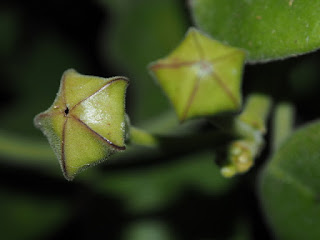Hoya madulidii is the 3rd hoya discussed here at In Focus. The first is Hoya siariae and 2nd is Hoya obscura, all endemic to the Philippines. H. madulidii is named after the botany head of our National Museum, an author of many books on plants, Dr. Domingo A. Madulid. It is formerly known as Hoya ciliata but the synonymy is not yet resolved. According to Burton, C., PS The Hoyan, Vol 9 #4, the correct name is Hoya ciliata as it was the previously published name. There is also a name called Eriostemma madulidii, but nobody is resolving the complications yet. The more commonly used name however, is Hoya madulidii.
My flowers were favorably colored black, but eventually turn lighter as the flowers age. They remain open for about 2 weeks, then wilted. Other plants i saw in the net are of different lighter color variations.
These are the already wilted flowers, which curled backwards mostly on the tips. Color lightens too. The flowers are bigger than many of the hoyas endemic here in the country. Oh i do not think it has a scent common with other hoyas.
about to open buds
Each flower at different stages of maturity grows from a common stem, unlike most hoyas that emerge to be an umbel in a common peduncle. It has a milky white sap that is very sticky and crumbles when dried.
The leaves of H madulidii are very pubescent or hirsute with the edges curling backwards. An authority told me that the curling is the obvious difference between Hoya ciliata, whole leaves remain flat. The vines continue to grow long and drooping to maturity before flowering. Maybe they droop because i continue to remove the upward twining vines, forced them to make a loop and hang.
The very young shoot and leaf of Hoya madulidii showing the lovely pubescence. It could probably endure direct sunlight because of this hairy leaf surfaces.








This is a great post! Your photos are stunning and I enjoyed reading all the information. Thank you so much for sharing with Today's Flowers and I wish you a very happy weekend :)
ReplyDeleteThanks so much Denise for appreciating what i wrote here, and the photos. Thanks also for hosting Today's Flowers, this is my first linking there at your admin.
DeleteThe last macro is simply fantastic. Such unusual flowers (for me at least) :)
ReplyDeleteMersad
Mersad Donko Photography
Mersad, thanks for saying that. It makes a lot of difference if the appreciation of a photo is from a very good photographer!
DeleteA scientific plant portrtait. I love it.
ReplyDeleteI know the white version of this flower and find the dark one a little ominous, but am grateful for its purpose in life.
Thank you for your kind comment on my sky picture.
I appreciate that Joanna, now i smiled at what a scientific plant portrait is. I didn't know that, i just take pictures whatever angle looks better. haha, thanks.
DeleteExcellent blog and fantastic photos as always.
ReplyDeleteHi Jan, thank you so much. Now you are not only an FB friend, a blogger friend too, lol.
DeleteSo gorgeous!
ReplyDeleteSo beautiful, and your macros are always amazing!
ReplyDeleteMy appreciation for that as well Beth. Thanks also for always dropping by.
DeleteWhat an interesting flower! We hav hoyas here but I don't think I've seen any that color.
ReplyDeleteOh it's good to know that there are hoya hobbyists in NZ too. It would be nice to see plants there in my next visit. Thanks for dropping by.
DeleteGorgeous! All hoyas are beautiful, but the colour of this one is really special.
ReplyDeleteOh yes Gunilla, black in hoyas is really special. This species though might be difficult to culture in Sweden nurseries unless planted in a phytotron to give it bright light and higher temperatures.
DeleteI've never seen Hoyas before, they are very interesting looking flowers. Great macro shots, especially the last one
ReplyDeleteHi Tony, there are many hoya growers in Australia but mainly in the mainland. I don't know anybody growing it in Tasmania, but cold weather is not a reason for not planting it. It is growing favorably in gardens in Sweden a little south of the Arctic.
DeleteThose are beautiful flowers. And your comments on my blog about the different natures of forests are perceptive. The forest I photographed was almost as high as trees grow on our mountains; it's almost alpine and if you go up a little higher you're in tundra.
ReplyDeleteThanks Al. I've seen a few temperate forests in person and they look almost the same. Yes, tundra, of course we don't have that, but we studied that in Landscape Ecology before; e.g. savanna, tundra, alpine. Some of those rockies in the US look like the rockies in Turkey.
Delete